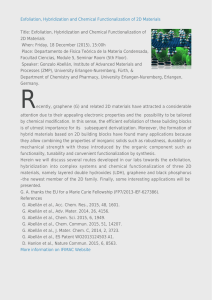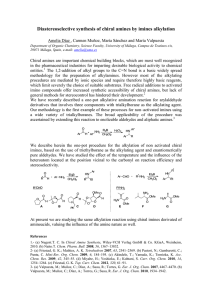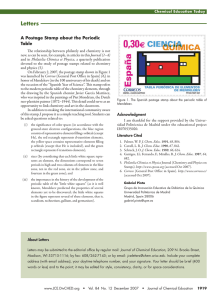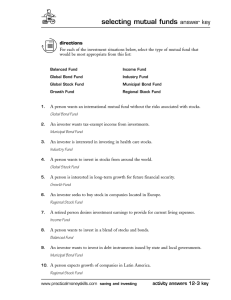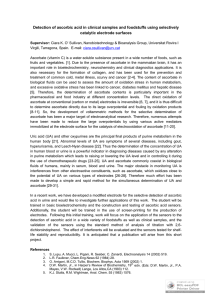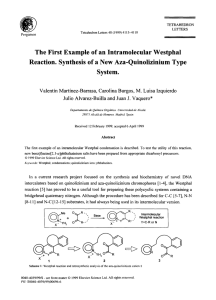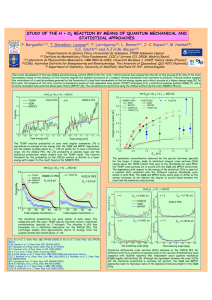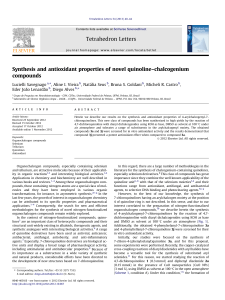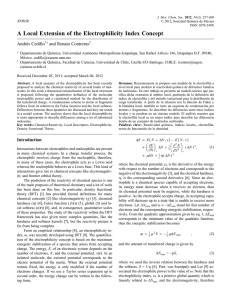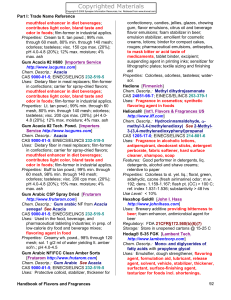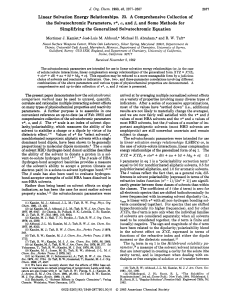Taming of the Silver FOX
Anuncio
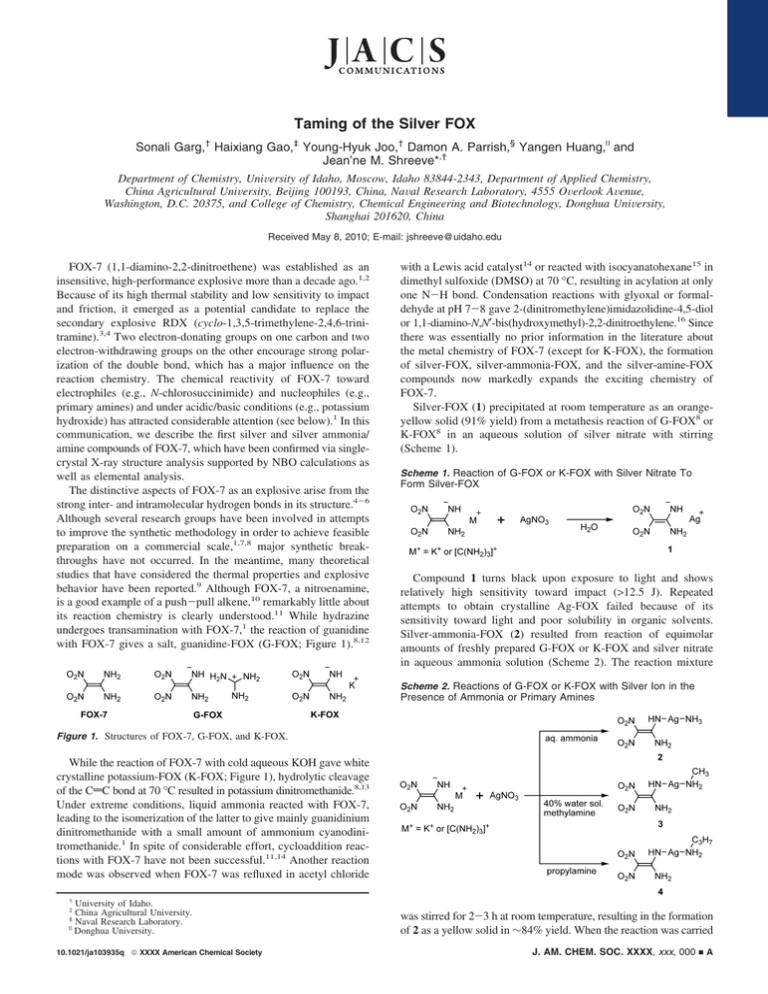
Taming of the Silver FOX † ‡ Sonali Garg, Haixiang Gao, Young-Hyuk Joo,† Damon A. Parrish,§ Yangen Huang,| and Jean’ne M. Shreeve*,† Department of Chemistry, UniVersity of Idaho, Moscow, Idaho 83844-2343, Department of Applied Chemistry, China Agricultural UniVersity, Beijing 100193, China, NaVal Research Laboratory, 4555 OVerlook AVenue, Washington, D.C. 20375, and College of Chemistry, Chemical Engineering and Biotechnology, Donghua UniVersity, Shanghai 201620, China Received May 8, 2010; E-mail: [email protected] FOX-7 (1,1-diamino-2,2-dinitroethene) was established as an insensitive, high-performance explosive more than a decade ago.1,2 Because of its high thermal stability and low sensitivity to impact and friction, it emerged as a potential candidate to replace the secondary explosive RDX (cyclo-1,3,5-trimethylene-2,4,6-trinitramine).3,4 Two electron-donating groups on one carbon and two electron-withdrawing groups on the other encourage strong polarization of the double bond, which has a major influence on the reaction chemistry. The chemical reactivity of FOX-7 toward electrophiles (e.g., N-chlorosuccinimide) and nucleophiles (e.g., primary amines) and under acidic/basic conditions (e.g., potassium hydroxide) has attracted considerable attention (see below).1 In this communication, we describe the first silver and silver ammonia/ amine compounds of FOX-7, which have been confirmed via singlecrystal X-ray structure analysis supported by NBO calculations as well as elemental analysis. The distinctive aspects of FOX-7 as an explosive arise from the strong inter- and intramolecular hydrogen bonds in its structure.4-6 Although several research groups have been involved in attempts to improve the synthetic methodology in order to achieve feasible preparation on a commercial scale,1,7,8 major synthetic breakthroughs have not occurred. In the meantime, many theoretical studies that have considered the thermal properties and explosive behavior have been reported.9 Although FOX-7, a nitroenamine, is a good example of a push-pull alkene,10 remarkably little about its reaction chemistry is clearly understood.11 While hydrazine undergoes transamination with FOX-7,1 the reaction of guanidine with FOX-7 gives a salt, guanidine-FOX (G-FOX; Figure 1).8,12 with a Lewis acid catalyst14 or reacted with isocyanatohexane15 in dimethyl sulfoxide (DMSO) at 70 °C, resulting in acylation at only one N-H bond. Condensation reactions with glyoxal or formaldehyde at pH 7-8 gave 2-(dinitromethylene)imidazolidine-4,5-diol or 1,1-diamino-N,N′-bis(hydroxymethyl)-2,2-dinitroethylene.16 Since there was essentially no prior information in the literature about the metal chemistry of FOX-7 (except for K-FOX), the formation of silver-FOX, silver-ammonia-FOX, and the silver-amine-FOX compounds now markedly expands the exciting chemistry of FOX-7. Silver-FOX (1) precipitated at room temperature as an orangeyellow solid (91% yield) from a metathesis reaction of G-FOX8 or K-FOX8 in an aqueous solution of silver nitrate with stirring (Scheme 1). Scheme 1. Reaction of G-FOX or K-FOX with Silver Nitrate To Form Silver-FOX Compound 1 turns black upon exposure to light and shows relatively high sensitivity toward impact (>12.5 J). Repeated attempts to obtain crystalline Ag-FOX failed because of its sensitivity toward light and poor solubility in organic solvents. Silver-ammonia-FOX (2) resulted from reaction of equimolar amounts of freshly prepared G-FOX or K-FOX and silver nitrate in aqueous ammonia solution (Scheme 2). The reaction mixture Scheme 2. Reactions of G-FOX or K-FOX with Silver Ion in the Presence of Ammonia or Primary Amines Figure 1. Structures of FOX-7, G-FOX, and K-FOX. While the reaction of FOX-7 with cold aqueous KOH gave white crystalline potassium-FOX (K-FOX; Figure 1), hydrolytic cleavage of the CdC bond at 70 °C resulted in potassium dinitromethanide.8,13 Under extreme conditions, liquid ammonia reacted with FOX-7, leading to the isomerization of the latter to give mainly guanidinium dinitromethanide with a small amount of ammonium cyanodinitromethanide.1 In spite of considerable effort, cycloaddition reactions with FOX-7 have not been successful.11,14 Another reaction mode was observed when FOX-7 was refluxed in acetyl chloride † University of Idaho. China Agricultural University. Naval Research Laboratory. | Donghua University. ‡ § 10.1021/ja103935q XXXX American Chemical Society was stirred for 2-3 h at room temperature, resulting in the formation of 2 as a yellow solid in ∼84% yield. When the reaction was carried J. AM. CHEM. SOC. XXXX, xxx, 000 9 A COMMUNICATIONS Figure 2. Asymmetric unit of the crystal structure of Ag(NH3)(FOX) 2. Selected distances (Å) and angles (deg): Ag-N9, 2.1067(18); Ag-N11, 2.1293(19); Ag-AgA, 3.1640(6); C1-N3, 1.364(3); C1-N6, 1.391(2); C1-C2, 1.488(3); C2-N9, 1.297(3); C2-N10, 1.333(2); N9-Ag-N11, 177.66(7); N9-Ag-AgA, 98.54(5); N11-Ag-AgA, 83.65(6); N3-C1-N(6), 122.98(18);N3-C1-C2,119.12(17);N6-C1-C2,117.89(17);N9-C2-N10, 122.67(18);N9-C2-C1,121.83(18);N10-C2-C1,115.49(17);C2-N9-Ag, 129.08(14). Symmetry transformation: A ) -x + 1, -y, -z. Figure 3. Packing diagram of 2 viewed down the b axis. Hydrogen atoms have been omitted for clarity. Dashed lines indicate short contacts. out with excess AgNO3 under analogous conditions, 2 was the exclusive product. Similarly, different primary amines were employed in order to determine the range of silver amino derivatives of FOX-7. When an aqueous solution of methylamine (40 wt % amine) was used with G-FOX or K-FOX, 3 precipitated as a yellow solid (85% yield). With propylamine, some water was added late in the reaction in order to precipitate 4 (80% yield). Compounds 2-4 were also obtained by stirring Ag-FOX or K-FOX in ammonia, methylamine, and propylamine solutions, respectively. While 2 and 4 are soluble in DMSO, 3 is only slightly soluble. None of these compounds 2-4 is light sensitive. Yellow crystals of 2 suitable for X-ray diffraction were obtained by slow evaporation of an aqueous ammonia solution at room temperature (Figure 2). The compound crystallizes in a monoclinic crystal system (space group P21/n) having four molecules in each unit cell (Figure 3). In the structure of 2, the C1dC2 olefin bond is ∼0.12 Å longer than the classical normal CdC double bond. Polarization of the CdC double bond occurs during complex formation, and this has been observed for compounds of FOX-7.1 The torsion angle of 90.2° between the nitro and amino groups suggests a large twist in the complex that orients the two groups perpendicular to each other. Most of the amino derivatives of FOX17 B J. AM. CHEM. SOC. 9 VOL. xxx, NO. xx, XXXX also show this structural feature, with the exception of 2-(1,1dinitromethylene)-1,3-diazapentene,18 which is essentially planar. As observed in FOX-7,6 one of the nitro groups is slightly out of plane, mainly because of electrostatic repulsion between the oxygens of the two nitro groups. The C2-N10 bond of the unsubstituted amino group is slightly longer (by ∼0.036 Å) than the substituted amino C2-N9 bond. However, both of these C-N bonds are shorter than normal C-N single bonds (∼1.41 Å) but similar to those in FOX-7 (1.31 and 1.32 Å), indicating that the negative charge is delocalized around the N10, C2, and N9 atoms. This result is in agreement with the structures of 1-amino-1-hydrazino-2,2dinitroethene19 and G-FOX.20 The silver atom is bonded linearly between the two nitrogen atoms with almost identical Ag-N bond lengths (Ag1-N9, 2.106 Å; Ag1-N11, 2.129 Å). These distances are similar to those in the structures of [Ag(N3)2]- 21a and [Ag(CN)2]-.21b-d The packing in 2 is built up from amino-nitro hydrogen bonding [N10 · · · O4#3 ) 3.053(2) Å, N10 · · · O5#4 ) 3.000(2) Å, N9 · · · O8#2 ) 3.246(2) Å, with the following symmetry transformations: #3 ) -x + 2, -y, -z; #4 ) -x + 5/2, y + 1/2, -z + 1/2; #2 ) -x + 2, -y, -z + 1] (Figure 3). The connectivity is augmented by short argentophilic interactions between Ag-Ag and Ag-O [Ag · · · Ag#1 ) 3.1640(6), Ag · · · O7#5 ) 2.7187(18) Å, with the following symmetry transformations: #1 ) -x + 1, -y, -z; #5 ) 3/2 - x, -1/2 + y, 1/2 - z] that create an interlinked sheet aligned along the b axis with Miller indices of ca. 2, 0, -2. The separation between the midpoints of each sheet is ∼7.7 Å. These argentophillic interactions are characteristic of dicyanoargentate salts.22 The differential scanning calorimetry (DSC) measurements for compounds 3 and 4 showed small endothermic melting points shortly before the compounds decomposed at 181.3 and 190.2 °C, respectively, whereas 1 and 2 have only one intense exothermic peak at 185.7 and 189.7 °C, respectively. The decomposition temperatures for 1-4 are comparable to those of G-FOX and K-FOX (see the Supporting Information).8 In contrast to 1 (>12.5 J), the impact sensitivities of 2-4 (>40 J) obtained using a BAM Fall hammer23 indicate that they are insensitive. In the 15N NMR spectra of 1, 2, and 4, a typical shift for the nitrogen atoms of the nitro groups was observed at -18.2 ppm. The nitrogen peak from ammonia (-381.7 ppm) was found to be at higher field than that from propylamine (-359.6 ppm). Because of the poor solubility of 3, the 15N NMR spectrum could not be obtained. The 1H NMR spectrum of 1 showed two broad signals, one at 7.1 ppm for NH protons and the other at 8.6 ppm for NH2 protons. In compounds 2-4, it was difficult to distinguish among the proton signals arising from NH, NH2, and amino groups because of broadening and overlapping of signals. These signals were observed over the range 3-8 ppm. A very slight shift in the 13C NMR resonances was observed for carbon bonded to nitro (131.7-130.9 ppm) or amino (160.0-160.3 ppm) groups relative to those in FOX-7 [128.5 ppm for C(NO2)2 and 158.8 ppm for C(NH2)2].1 To obtain a better understanding of silver-ammonia-FOX 2, a natural bond orbital (NBO) population analysis fixed at the optimized structure (DFT/3-21G) was used to investigate the bonding and hybridization in this species (single-point energy calculated at the DFT/3-21G level) (Figure 4). The calculations were carried out using the Gaussian 03 suite of programs (revision D.01).24 The geometry optimizations of the structures and frequency analyses were carried out using the B3LYP functional with the 3-21G basis set. The optimized structures were characterized as true local energy minima on the potential energy surface without imaginary frequencies. COMMUNICATIONS References Figure 4. NBO analysis of 2 showing net charges on the atoms. The NBO analysis showed that C2 is more positively charged than C1, indicating polarization of the double bond. The polarization of the ethylene bond is much less in this case than that found for mono- or disubstituted derivatives of FOX-7.18-20 The amino N9 and N10 atoms have essentially the same charge, which supports the conjugative effect between the two amino groups. A high concentration of negative charge on the ammonia nitrogen tends to stabilize the silver atom, thus enhancing bond formation with the FOX molecule. For comparison, NBO analysis using the MPW1PW91/SDD level of theory24 was also performed, and the charge distribution results from the two methods were found to be in close agreement. With the exception of the values for the dihedral angles, the calculated geometric parameters using the two methods are comparable to the experimental values found for 2. The difference in the dihedral angles arises from comparing the gasphase structure from the calculations, which is not subjected to any intermolecular interactions, with the solid-state from the X-ray analysis. In conclusion, we have synthesized the first non-potassium metal complexes of FOX-7: Ag-FOX, Ag-ammonia-FOX, Ag-methylamine-FOX, and Ag-propylamine-FOX. With the exception of AgFOX, which is light-sensitive and somewhat sensitive to impact, the Ag-ammonia/amine-FOX materials are thermally (>184 °C) and hydrolytically stable as well as impact-insensitive; they are readily obtained from reaction of Ag-FOX with aqueous ammonia or the aqueous amine or reaction of G-FOX or K-FOX with silver nitrate in aqueous ammonia or amine. The structure of Ag-ammonia-Fox was confirmed on the basis of single-crystal X-ray analysis; all of the structures are supported by elemental analysis, and the Agammonia-FOX derivative is further understood on the basis NBO calculations. Acknowledgment. The authors gratefully acknowledge the support of the Defense Threat Reduction Agency (HDTRA1-071-0024), the National Science Foundation (CHE-0315275), and the Office of Naval Research (N00014-06-1-1032). Supporting Information Available: CIF file for 2, NBO charge distribution and bond distances and angles, results of DSC measurements, and complete ref 24. This material is available free of charge via the Internet at http://pubs.acs.org. (1) Bellamy, A. J. Struct. Bonding 2007, 125, 1–33, and references cited therein. (2) Latypov, N. V.; Bergman, J.; Langlet, A.; Wellmar, U.; Bemm, U. Tetrahedron 1998, 54, 11525–11536. (3) (a) Kuklja, M. M.; Rashkeev, S. N. J. Phys. Chem. C 2009, 113, 17–20. (b) Powala, D.; Orzechowski, A.; Paplinski, A.; Maranda, A. New Trends Res. Energ. Mater., Proc. Semin. 12th 2009, 781–786. (c) Trzcinski, W. A.; Cudzilo, S.; Chylek, Z.; Szymanczyk, L. J. Hazard. Mater. 2008, 157, 605– 612. (d) Zhao, J.; Liu, H. Comput. Mater. Sci. 2008, 42, 698–703. (e) Fan, X.-Z.; Li, J.-Z.; Liu, Z.-R. J. Phys. Chem. A 2007, 111, 13291–13295. (f) Trzcinski, W. A.; Cudzilo, S.; Chylek, Z.; Szymanczyk, L. Int. Annu. Conf. ICT, Proc. 37th 2006, 1–10. (g) Wild, R.; Teipel, U. Int. Annu. Conf. ICT, Proc. 35th 2004, 1–9. (h) Janzon, B.; Bergman, H.; Eldstäter, C.; Lamnvik; Östmark, H. Int. Symp. Ballist., Proc. 20th 2002, 686–693. (4) Burnham, A. K.; Weese, R. K.; Wang, R.; Kwok, Q. S. M.; Jones, D. E. G. Int. Annu. Conf. ICT, Proc. 36th 2005, 1–12. (5) (a) Crawford, M.-J.; Evers, J.; Göbel, M.; Klapötke, T. M.; Mayer, P.; Oehlinger, G.; Welch, J. M. Propellants, Explos., Pyrotech. 2007, 32, 478– 495. (b) Evers, J.; Klapötke, T. M.; Mayer, P.; Oehlinger, G.; Welch, J. Inorg. Chem. 2006, 45, 4996–5007. (c) Kempa, P. B.; Herrmann, M.; Metzger, F. J. M.; Thome, V.; Kjellström, A.; Latypov, N. V. Int. Annu. Conf. ICT, Proc. 35th 2004, 1–15. (6) Bemm, U.; Ostmark, H. Acta Crystallogr., Sect. C 1998, 54, 1997–1999. (7) (a) Johansson, M.; Latypov, N. V.; Holmgren, E.; Sizova, E. V.; Sizov, V.; Bellamny, A. J. New Trends Res. Energ. Mater., Proc. Semin. 10th 2007, 183–190. (b) Cai, H.; Shu, Y.; Huang, H.; Cheng, B.; Li, J. J. Org. Chem. 2004, 69, 4369–4374. (8) Anniyappan, M.; Talawar, M. B.; Gore, G. M.; Venugopalan, S.; Gandhe, B. R. J. Hazard. Mater. 2006, 137, 812–819. (9) (a) Zong, H.; Shu, Y.-J.; Huang, Y.-G. Int. Annu. Conf. ICT, Proc. 40th 2009, 1–8. (b) Liu, M.-H.; Cheng, K.-F.; Chen, C.; Hong, Y.-S. Int. J. Quantum Chem. 2009, 109, 1618–1625. (c) Kuklja, M. M.; Rashkeev, S. N. Phys. ReV. B 2007, 75, 104111. (d) Hu, A.; Larade, B.; Dudiy, S.; AbouRachid, H.; Lussier, L.-S.; Guo, H. Propellants, Explos., Pyrotech. 2007, 32, 331–337. (e) Kimmel, A. V.; Sushko, P. V.; Shulger, A. L.; Kuklja, M. M. J. Chem. Phys. 2007, 126, 234711. (f) Hu, A.; Larade, B.; Dudiy, S.; Abou-Rachid, H.; Lussier, L.-S.; Guo, H. Propellants, Explos., Pyrotech. 2006, 31, 355–360. (g) Politzer, P.; Concha, M. C.; Grice, M. E.; Murray, J. S.; Lane, P. THEOCHEM 1998, 452, 75–83. (10) Rajappa, S. Tetrahedron 1981, 37, 1453–1480. (11) (a) Hervé, G. Propellants, Explos., Pyrotech. 2009, 34, 444–451. (b) Hervé, G.; Jacob, G. Tetrahedron 2007, 63, 953–959. (12) Sandberg, C.; Latypov, N. V.; Goede, P.; Tryman, R.; Bellamy, A. J. New Trends Res. Energ. Mater., Proc. Semin. 5th 2002, 292–299. (13) (a) Bellamy, A. J.; Latypov, N. V.; Goede, P. J. Chem. Res., Synop. 2002, 257–257. (b) Bellamy, A. J. G.; Goede, P.; Sandberg, C.; Latypov, N. V. Int. Annu. Conf. ICT, Proc. 33rd 2002, 1–9. (14) Hervé, G.; Jacob, G.; Latypov, N. V. Tetrahedron 2005, 61, 6743–6748. (15) Bellamy, A. J.; Contini, A. E.; Andrews, M. R. G. New Trends Res. Energ. Mater., Proc. Semin. 12th 2009, 473–480. (16) Sizova, E. V.; Sizov, V. V.; Tselinskii, I. V. Russ. J. Org. Chem. 2007, 43, 1232–1237. (17) Baum, K.; Bigelow, S. S.; Nguyen Nghi, V.; Archibald, T. G.; Gilardi, R.; Flippen-Anderson, J. L.; George, C. J. Org. Chem. 1992, 57, 235–241. (18) Xu, K.; Song, J.; Yang, X.; Chang, C.; Yang, X.; Ma, H.; Huang, J.; Zhao, F. J. Mol. Struct. 2008, 891, 340–345. (19) Chang, C.-R.; Xu, K.-Z.; Song, J.-R.; Yan, B.; Ma, H.-X.; Gao, H.-X.; Zhao, F.-Q. Acta Chim. Sin. 2008, 66, 1399–1404. (20) Xu, K.-Z.; Chang, C.-R.; Song, J.-R.; Zhao, F.-Q.; Ma, H.-X.; Lü, X.-Q.; Hu, R.-Z. Chin. J. Chem. 2008, 26, 495–499. (21) (a) Klapötke, T. M.; Krumm, B.; Scherr, M. J. Am. Chem. Soc. 2009, 131, 72–74. (b) Beno, M. A.; Firestone, M. A.; Leung, P. C. W.; Sowa, L. M.; Wang, H. H.; Williams, J. M.; Whangbo, M.-H. Solid State Commun. 1986, 57, 735–739. (c) Klapötke, T. M.; Krumm, B.; Mayer, P.; Piotrowski, H.; Schwab, I.; Vogt, M. Eur. J. Inorg. Chem. 2002, 2701–2709. (d) Dobbs, W.; Suisse, J.-M.; Douce, L.; Welter, R. Angew. Chem., Int. Ed. 2006, 45, 4179–4182. (22) (a) Pham, D. M.; Rios, D.; Olmstead, M. M.; Balch, A. L. Inorg. Chim. Acta 2005, 358, 4261–4269. (b) Triščı́ková, L.; Potočňák, I.; Wanger, C. Acta Crystallogr., Sect. C 2002, 58, m246–m248. (23) (a) www.bam.de. (b) A 20 mg portion of each of the compounds silverFOX 1, silver-ammonia-FOX 2, and silver-amine-FOX compounds 3 and 4 was subjected to a Bam Fallhammer test using a 5 or 10 kg weight. The results are characterized as follows: insensitive, >40 J; less sensitive, g35 J; sensitive, g4 J; very sensitive, e3 J. (24) Frisch, M. J.; et al. Gaussian 03, revision D.01; Gaussian, Inc.: Wallingford, CT, 2004. JA103935Q J. AM. CHEM. SOC. 9 VOL. xxx, NO. xx, XXXX C
